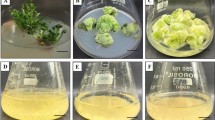Abstract
Cell suspension cultures of Arnebia euchroma were established from the friable callus on liquid Murashige and Skoog medium supplemented with 6-benzylaminopurine (10.0 μM) and indole-3-butyric acid (5.0 μM). Salicylic acid was used to study its effect on the enzymes which participate in shikonin biosynthesis with respect to metabolite (shikonin) content in the cell suspension culture of A. euchroma. In our study, phenylalanine ammonia lyase and PHB geranyltransferase were selected from the entire biosynthetic pathway. Results showed that phenylalanine ammonia lyase is responsible for growth and PHB geranyltransferase for metabolite production. Salicylic acid exhibited an inverse relationship with the metabolite content (shikonin); salicylic acid (100 μM) completely inhibited shikonin biosynthesis. The results presented in the current study can be successfully employed for the metabolic engineering of its biosynthetic pathway for the enhancement of shikonin, which will not only help in meeting its industrial demand but also lead to the conservation of species in its natural habitat.









Similar content being viewed by others
References
Sasaki, K., Abe, H., & Yoshizaki, F. (2002). In vitro antifungal activity of naphthoquinone derivatives. Biological and Pharmaceutical Bulletin, 25(5), 669–670.
Hayashi, M. (1977). Pharmacological studies of shikon andtTooki. (3) Effect of topical application of the ether extracts and shiunko on inflammatory reactions. Nippon Yakurigaku Zasshi, 73, 205–214.
Ahn, B. Z., Baik, K. U., Kweon, G. R., Lim, K., & Hwang, B. D. (1995). Acetylshikonin analogues:synthesis and inhibition of DNA topoisomerase-I. Journal of Medicinal Chemistry, 38, 1044–1047.
Ueba, N., Otake, T., Yazaki, K., Mori, H., & Morimoto, M. (1993). Anti-HIV-1 activities of crude drug, shikon (Lithospermiradix), in vitro. Nippon Risho, 51(Suppl), 207–212.
Tanka, Y., & Odani, T. (1972). Pharmacology study on shiunko—I. Antibacterial effect of shiunko. Yakugaku Zasshi, 92, 525–530.
Sankawa, U., Ebizuka, Y., Miyazaki, T., Isomura, Y., Otsuka, H., Shibata, S., et al. (1977). Antitumor activity of shikonin and its derivatives. Chemical and Pharmaceutical Bulletin, 25, 2392–2395.
Papageorgiou, V. P., Assimopoulou, A. N., Couladouros, E. A., Hepworth, D., & Nicolaou, K. C. (1999). The chemistry and biology of alkannin, shikonin and related naphthazarin natural products. Angewandte Chemie International Edition, 38, 270–300.
Malik, S., Bhushan, S., Sharma, M., & Ahuja, P. S. (2011). Physico-chemical factors influencing the pigment production in cell suspension cultures of Arnebia euchroma (Royle) Johnston, a medicinally important plant species. Cell Biology International, 35, 153–158.
Kala, C. P., Dhar, U., & Farooquee, N. A. (2004). Prioritization of medicinal plants on the basis of available knowledge, existing practices and use value status in Uttaranchal, India. Biodiversity and Conservation, 13, 453–469.
Manjkhola, S., Dhar, U., & Joshi, M. (2005). Organogenesis, embryogenesis, and synthetic seed production in Arnebia euchroma—a critically endangered medicinal plant of the Himalaya. In Vitro Cellular & Developmental Biology. Plant, 41, 244–248.
Tabata, M., Mizukami, H., Hiraoka, N., & Konoshima, M. (1974). Pigment formation in callus cultures of Lithospermum erythrorhizon. Phytochemistry, 13, 927–932.
Newman, J. D., & Chappell, J. (1999). Isoprenoid biosynthesis in plants: carbon partitioning within the cytoplasmic pathway. Critical Reviews in Biochemistry and Molecular Biology, 34, 95–106.
Heide, L., Nishioka, N., Fukui, H., & Tabata, M. (1989). Enzymatic regulation of shikonin biosynthesis in Lithospermum erythrorhizon cell cultures. Phytochemistry, 28, 1873–1877.
Yazaki, K., Tanaka, S., Matsuoka, H., & Sato, F. (1998). Stable transformation of Lithospermum erythrorhizon by Agrobacterium rhizogenes and shikonin production of the transformants. Plant Cell Reports, 18, 214–219.
Hussain, M. S., Fareed, S., Ansari, S., Rahman, M. A., Ahmad, I. Z., & Saeed, M. (2012). Current approaches toward production of secondary plant metabolites. Journal of Pharmacy and Bioallied Sciences, 4, 10–20.
MacDonald, M. J., & D’Cunha, G. B. (2007). A modern view of phenylalanine ammonia lyase. Biochemistry and Cell Biology, 85, 273–282.
Baranek, K. S., Pietrosiuk, A., Naliwajski, M. R., Kawiak, A., Jeziorek, M., Wyderska, S., et al. (2012). Effect of l-phenylalanine on PAL activity and production of naphthoquinone pigments in suspension cultures of Arnebia euchroma (Royle) Johnst. In Vitro Cellular & Developmental Biology-Plant, 48, 555–564.
Singh, R. S., Gara, R. K., Bhardwaj, P. K., Kachara, A., Malik, S., Kumar, R., et al. (2010). Expression of 3-hydroxy-3-methylglutaryl-CoA reductase, p-hydroxybenzoate-m-geranyltransferase and genes of phenylpropanoid pathway exhibits positive correlation with shikonins content in arnebia [Arnebia euchroma (Royle) Johnston]. BMC Molecular Biology, 11, 88.
Xuqing, F., & Dewei, L. (1998). Enhancement of shikonin production in cell suspension cultures of Arnebia euchroma employing two liquid phase systems. Chinese Journal of Chemical Engineering, 6(1), 86–90.
Tabata, M., & Fujita, Y. (1985). Production of shikonin by plant cell cultures. In P. Day, M. Zaitlin, & A. Hollaender (Eds.), Biotechnology in Plant Science (pp. 207–218). Orlando: Academic.
Gaisser, S., & Heide, L. (1996). Inhibition and regulation of shikonin biosynthesis in suspension cultures of Lithospermum. Phytochemistry, 41, 1065–1072.
Acknowledgments
Financial support from the Council of Scientific and Industrial Research (CSIR), New Delhi, India, has been greatly acknowledged.
Author information
Authors and Affiliations
Corresponding author
Rights and permissions
About this article
Cite this article
Kumar, P., Saini, M., Bhushan, S. et al. Effect of Salicylic Acid on the Activity of PAL and PHB Geranyltransferase and Shikonin Derivatives Production in Cell Suspension Cultures of Arnebia euchroma (Royle) Johnst—a Medicinally Important Plant Species. Appl Biochem Biotechnol 173, 248–258 (2014). https://doi.org/10.1007/s12010-014-0838-x
Received:
Accepted:
Published:
Issue Date:
DOI: https://doi.org/10.1007/s12010-014-0838-x




